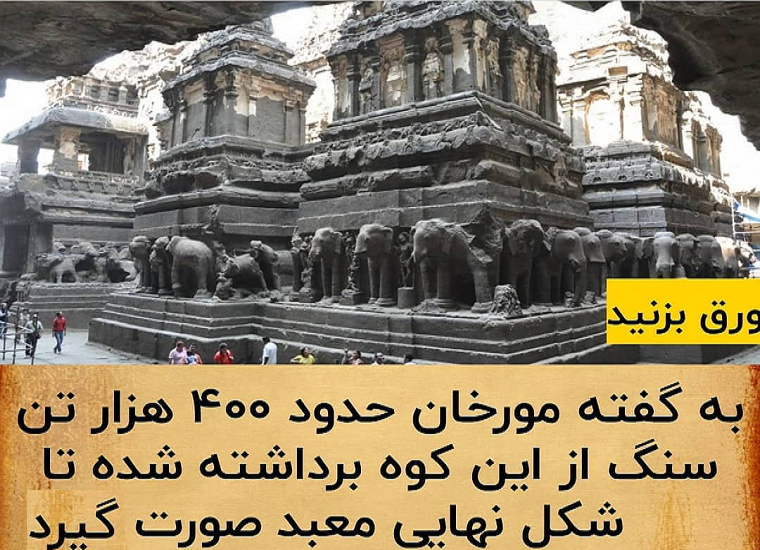 M. K. Dhavalikar (1982) analyzed the architecture of the temple and concluded that the major part of the temple was completed during the reign of Krishna I, although he agreed with Goetz that some other parts of the temple complex can be dated to the later rulers. According to Dhavalikar, the following components were completed by Krishna: the main shrine, its gateway, the Nandi-mandapa, the lower story, the elephant-lion frieze, the court elephants, and the victory pillars. Dhavalikar admits that the most important sculpture of the temple, which depicts Ravana shaking the Kailasa mountain, appears to have been built after the main edifice. This sculpture is considered one of the finest pieces of Indian art, and it is possible that the temple came to be known as Kailasa after it. Dhavalikar theorizes that this sculpture was carved around 3-4 decades after the completion of the main shrine, on the basis of its similarity to the tandava sculpture in the Lankeshvar cave. H. Goetz dated this relief to the reign of Krishna III. Like Goetz, Dhavalikar attributes some other structures in the temple complex to the later rulers. These include the Lankeshvar cave and the shrine of the river goddesses (possibly constructed during the reign of Govinda III). Dhavalikar further theorizes that the excavation of the Dashavatara cave, which began during the reign of Dantidurga, was completed during the reign of Krishna I. This explains the similarities between the sculptures in the two caves
M. K. Dhavalikar (1982) analyzed the architecture of the temple and concluded that the major part of the temple was completed during the reign of Krishna I, although he agreed with Goetz that some other parts of the temple complex can be dated to the later rulers. According to Dhavalikar, the following components were completed by Krishna: the main shrine, its gateway, the Nandi-mandapa, the lower story, the elephant-lion frieze, the court elephants, and the victory pillars. Dhavalikar admits that the most important sculpture of the temple, which depicts Ravana shaking the Kailasa mountain, appears to have been built after the main edifice. This sculpture is considered one of the finest pieces of Indian art, and it is possible that the temple came to be known as Kailasa after it. Dhavalikar theorizes that this sculpture was carved around 3-4 decades after the completion of the main shrine, on the basis of its similarity to the tandava sculpture in the Lankeshvar cave. H. Goetz dated this relief to the reign of Krishna III. Like Goetz, Dhavalikar attributes some other structures in the temple complex to the later rulers. These include the Lankeshvar cave and the shrine of the river goddesses (possibly constructed during the reign of Govinda III). Dhavalikar further theorizes that the excavation of the Dashavatara cave, which began during the reign of Dantidurga, was completed during the reign of Krishna I. This explains the similarities between the sculptures in the two caves
Kailasa, A Temple That Modern Man Cannot Build
 M. K. Dhavalikar (1982) analyzed the architecture of the temple and concluded that the major part of the temple was completed during the reign of Krishna I, although he agreed with Goetz that some other parts of the temple complex can be dated to the later rulers. According to Dhavalikar, the following components were completed by Krishna: the main shrine, its gateway, the Nandi-mandapa, the lower story, the elephant-lion frieze, the court elephants, and the victory pillars. Dhavalikar admits that the most important sculpture of the temple, which depicts Ravana shaking the Kailasa mountain, appears to have been built after the main edifice. This sculpture is considered one of the finest pieces of Indian art, and it is possible that the temple came to be known as Kailasa after it. Dhavalikar theorizes that this sculpture was carved around 3-4 decades after the completion of the main shrine, on the basis of its similarity to the tandava sculpture in the Lankeshvar cave. H. Goetz dated this relief to the reign of Krishna III. Like Goetz, Dhavalikar attributes some other structures in the temple complex to the later rulers. These include the Lankeshvar cave and the shrine of the river goddesses (possibly constructed during the reign of Govinda III). Dhavalikar further theorizes that the excavation of the Dashavatara cave, which began during the reign of Dantidurga, was completed during the reign of Krishna I. This explains the similarities between the sculptures in the two caves
M. K. Dhavalikar (1982) analyzed the architecture of the temple and concluded that the major part of the temple was completed during the reign of Krishna I, although he agreed with Goetz that some other parts of the temple complex can be dated to the later rulers. According to Dhavalikar, the following components were completed by Krishna: the main shrine, its gateway, the Nandi-mandapa, the lower story, the elephant-lion frieze, the court elephants, and the victory pillars. Dhavalikar admits that the most important sculpture of the temple, which depicts Ravana shaking the Kailasa mountain, appears to have been built after the main edifice. This sculpture is considered one of the finest pieces of Indian art, and it is possible that the temple came to be known as Kailasa after it. Dhavalikar theorizes that this sculpture was carved around 3-4 decades after the completion of the main shrine, on the basis of its similarity to the tandava sculpture in the Lankeshvar cave. H. Goetz dated this relief to the reign of Krishna III. Like Goetz, Dhavalikar attributes some other structures in the temple complex to the later rulers. These include the Lankeshvar cave and the shrine of the river goddesses (possibly constructed during the reign of Govinda III). Dhavalikar further theorizes that the excavation of the Dashavatara cave, which began during the reign of Dantidurga, was completed during the reign of Krishna I. This explains the similarities between the sculptures in the two caves
 newsoholic Time to become News Oholic!
newsoholic Time to become News Oholic!